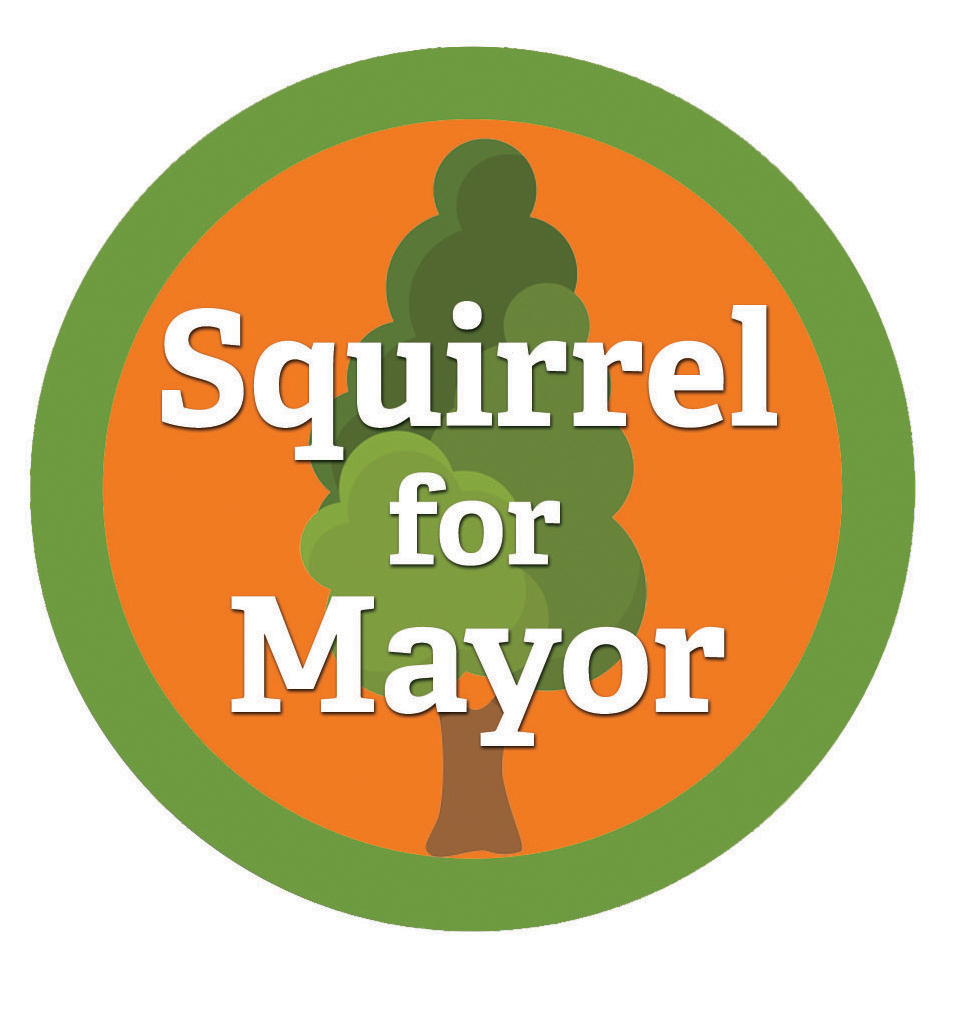Tree Protection bylaws for the urban forest are municipal. Each municipality is slightly different, but they are all affected by provincial legislation. Citizens believe that these bylaws protect the urban forest. The word “protection” is in the name, so it’s a fair assumption, but it requires a deeper look.
Let’s use the City of Victoria’s Tree Protection Bylaw (TPB 21-035) as an example. The bylaw has not been updated since the introduction of City of Victoria’s Missing Middle Housing (MMH) and the Province of BC Bills 44 and 37, or the upcoming draft Victoria OCP “Vision 2050”. This is significant because housing policies which prioritize the built environment can undermine physical protections for trees and tree minimums through developments established in the Tree Protection Bylaw – and the trees and wildlife they support. Any tree can be removed for the development of a building, including Specimen trees.
Over 75% of the urban forest is on private property, specifically single-family dwelling lots. According to the City of Victoria’s Director of Parks at an April 2025 COTW meeting, the urban forest is made up of 34,000 trees on public land, and 115,000 trees on private property.
Developers must adhere to the City of Victoria Tree Protection Bylaw, yet there is room for improvement. Old-growth, pre-colonial settlement trees greater than 250 years of age persist in every neighbourhood in Victoria, and replacement trees are needed to establish the next generation. Between 2020 to 2023, only 68 replacement trees on private property were native species, compared to 354 introduced/exotic species, resulting in a 1:5 ratio (City of Victoria Open Data).
A developer can apply to remove trees within a proposed new building envelope, and pay cash-in-lieu into the Tree Reserve Fund ($2000 per tree) when the proposed new setbacks are decreased and don’t leave room to replant trees. Cash in lieu is 1:1, whereas replacing a specimen tree is 3:1. (3 trees planted to replace 1 mature Garry oak).
When a new development does not provide the same amount of contiguous plantable space as the old building footprint, the developer will choose to pay cash-in-lieu with the idea that these missing trees will get replanted on public property. Problem is, there’s no more plantable / park space in the City of Victoria, and trees are needed at the neighbourhood level for climate resilience, more than in parks. Additionally, to replace a tree in a soil cell (no existing soil), it costs $10,000 to plant per tree. Since the City is only collecting $2000 for each tree removed, it’s going to be difficult to catch up with the loss over time.
For example, the City of Victoria’s Tree Reserve Fund has collected nearly 1.8 million dollars for developments that did not meet the tree replacement minimums from January 2021 to March 2024, and the City spent only $65,000 during that same time. However, the accumulation of funds in the Tree Reserve between 2021-2023 is evidence of that ineffectiveness. In only 3 years the City accumulated $1,047,000 from developments that could not achieve the tree minimum, which equals net deficit of 523 trees from private property (trees never replanted).

Missing Middle Housing is subject to Schedule P – Missing Middle Regulations (Amended December 7, 2023 Bylaw 23-099). You can read how the urban forest is affected in Section 3.4 Site Coverage 40% (building footprint), Open Site Space 45% (decks, permeable driveways, staircases, etc.), and a single space 6.5% (contiguous permeable space to plant a tree). Contiguous plantable space, which I explained in this post, is the leading indicator of a sustainable urban forest, while overall tree canopy measurement is a lagging indicator.
While most citizens would likely picture open site space as an area with grass, garden beds, and trees, this is not the case. Before the proposed Missing Middle regulations were approved, an astute observer wrote a letter on August 04, 2022 to City of Victoria Mayor and Council in advance of the public hearing to point out the issues, correctly stating, “This means that while still following these regulations, the property owner may add landscaping such as a concrete patio, sheds, decks, pools and fake grass, and these would all count as ‘open space’” and “a developer who purchases a single-family dwelling lot can put have impermeable surfaces on up to 93.5% of their lot.” Actually, they can have more than 93.5% because plantable space is a variance, and is not legislated.
An email on August 10, 2022 from City Planner Malcolm Maclean, confirmed this in an email before the public hearing:
“While the definition of “open site space” in our Zoning Regulation Bylaw does allow for paved pathways and accessory garden structures, a number of things contribute toward limiting impervious pavement within the open site space surrounding missing middle housing:
- The Design Guidelines provide direction to ensure green landscaped areas of the site. They also establish a mandatory rainwater management performance target (guideline 1.7.13.) with green open spaces and permeable paving being key strategies to achieve this. The guidelines do also support some impervious paving for the sake of ensuring accessible pathways, considering the requirements for adaptable dwelling units.
- The proposed regulations require 6.5% of site space (or a minimum of 35 square metres) to be free of pavement or above/below ground structures. This corresponds to ensuring space for the roots of a large canopy tree (or more on larger than standard lots).
- The requirements for tree protection, replacement, and minimums established by the Tree Protection Bylaw will inform landscape planning that demonstrates space for the continued health of each regulated tree on the site, further limiting the extent of pavement within the open site space.
Given site-specific considerations associated with all the above, it’s not possible to quantify a specific amount of soft vs. hardscaping expected on all sites, but the prevalence of soft landscaping and permeable paving will be an important aspect of site plan reviews.”
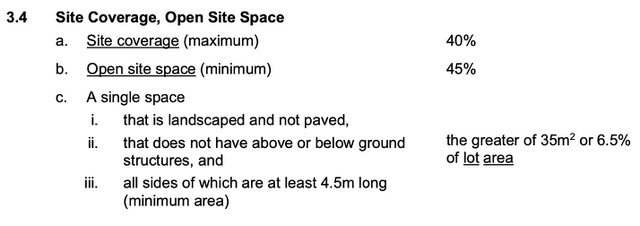
Here is a recent example of a proposed Missing Middle development project previously zoned SFH (subject to City staff review).
- The plan states there is open site space of 32.3% (not 45%)
- Arborist report reflects only four planting spaces for a total of 56 sq m of soil volume to support one medium and four small trees. The proposed planting spaces do not have adequate soil volumes to support large canopy trees . Magnolia trees are proposed, small in size and non-native.
- Seven trees and one hedge are proposed for removal – six of the tree removals are proposed on-site and one municipal tree is proposed for removal for the driveway crossing on XXXXX Lane. The species proposed for removal are: Western Redcedar (municipal), Garry Oak x 4, False Cypress and English Laurel (hedge). The sizes are varied, ranging from 39 cm diameter at breast height (DBH) to 85 cm DBH.
You will note that since the open site space (which is a variance and not legislated) is not meeting the minimum requirements, and there is no measurement yet for plantable space (also a variance and not legislated). We will not know how much plantable space was achieved, or how close the developer came to the suggested 6.5% contiguous plantable space, until the end of the project.
Here is an example of a completed project, built under the City of Victoria’s Missing Middle guidelines. You can see how many trees were removed in the landscape plan below, and how, with adjustments, far more mature trees and plantable space could have been saved. It’s a bit shocking considering how other cities are attempting to rewild their neighbourhoods to become more climate resilient, while the City of Victoria is heading toward the climate crisis issues that many other cities are already facing.
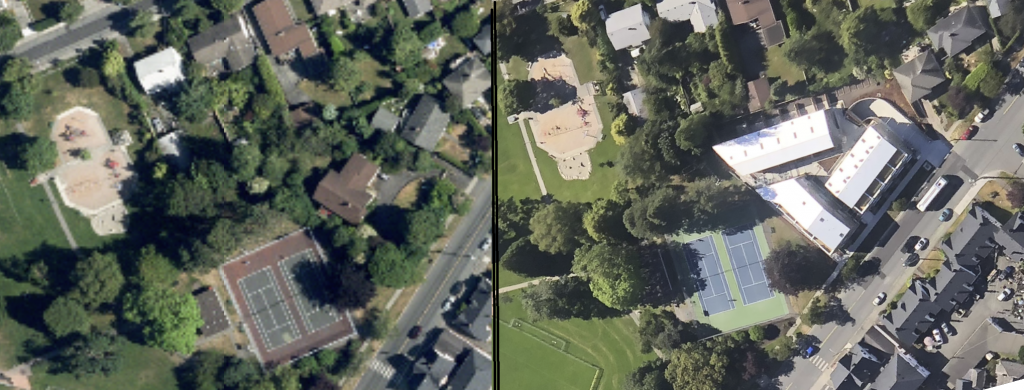
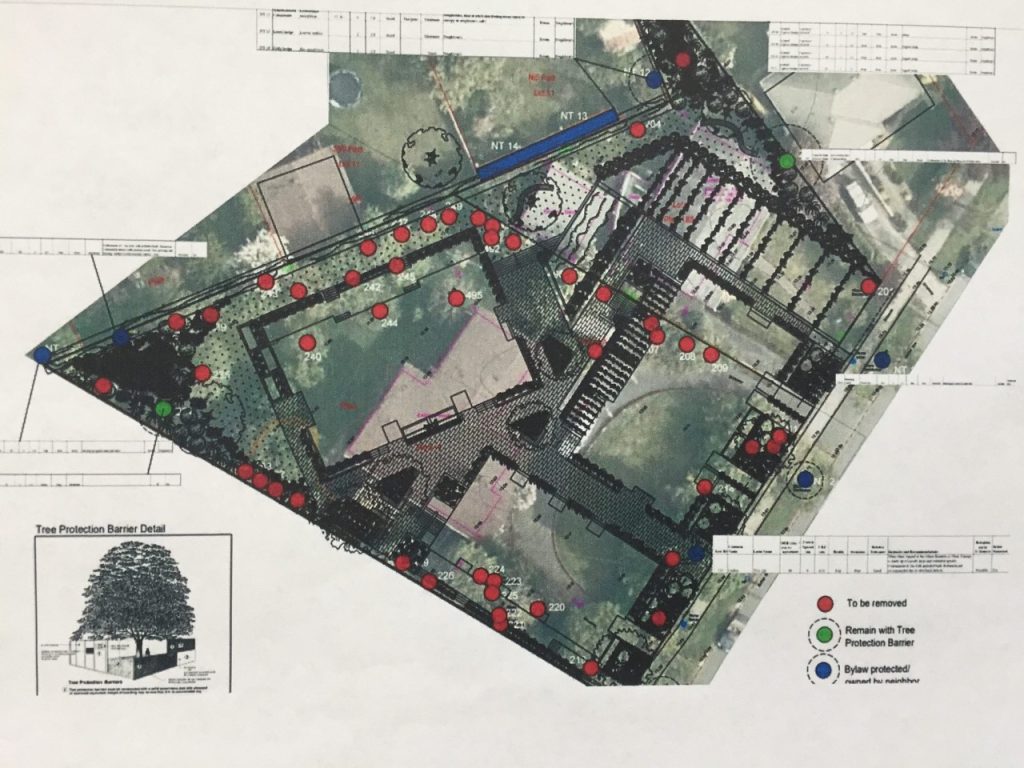
In addition, the project imagery (below) shows a trend that occurred just before the Missing Middle Housing was passed to illustrate how projects are often supported by Council in the months leading up to land use regulation changes. The loss of contiguous plantable space for urban tree canopy is quite clear, however, it’s important to note that decreased setbacks are occurring with most new building forms, regardless of whether it is SFH (single-family house) to MMH or SFH to a larger SFH.
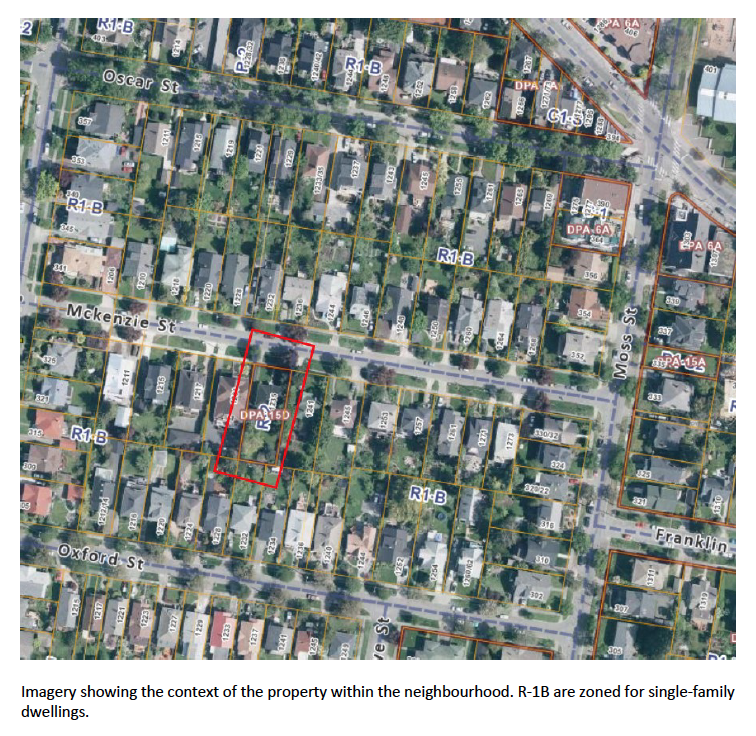
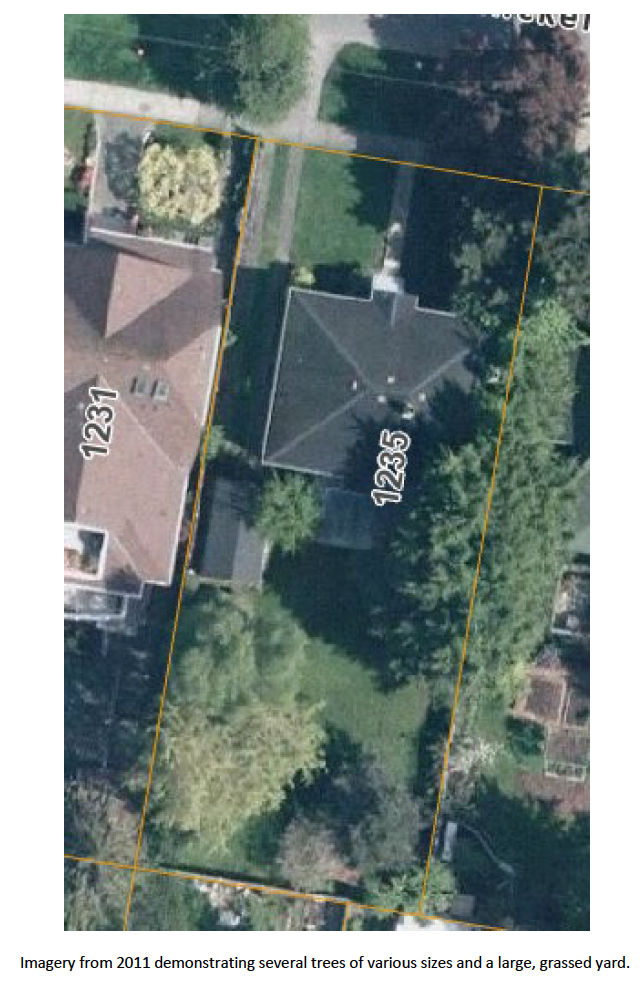
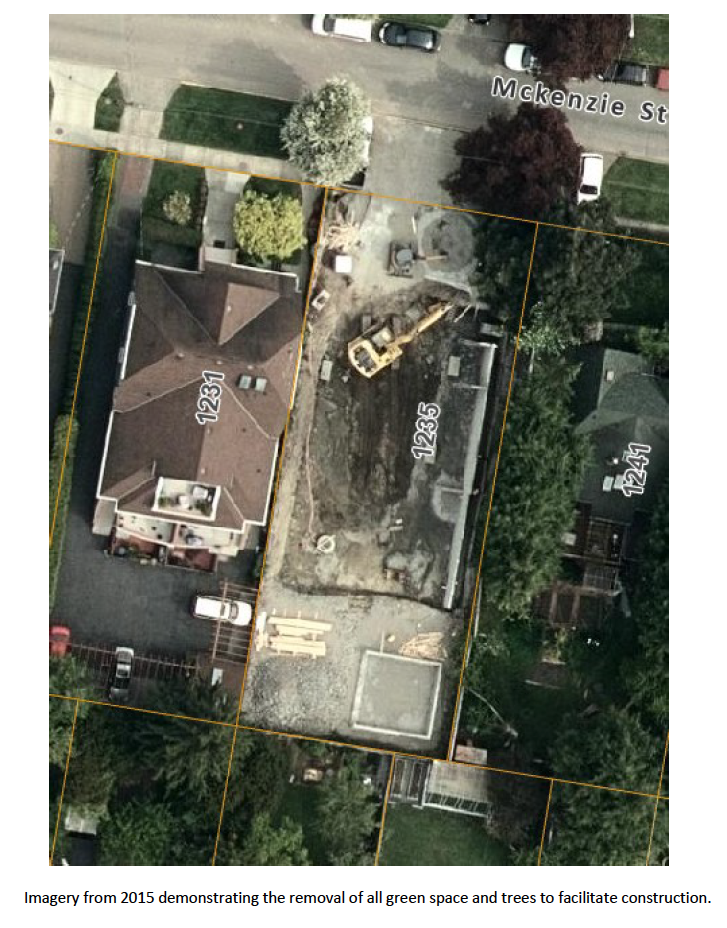
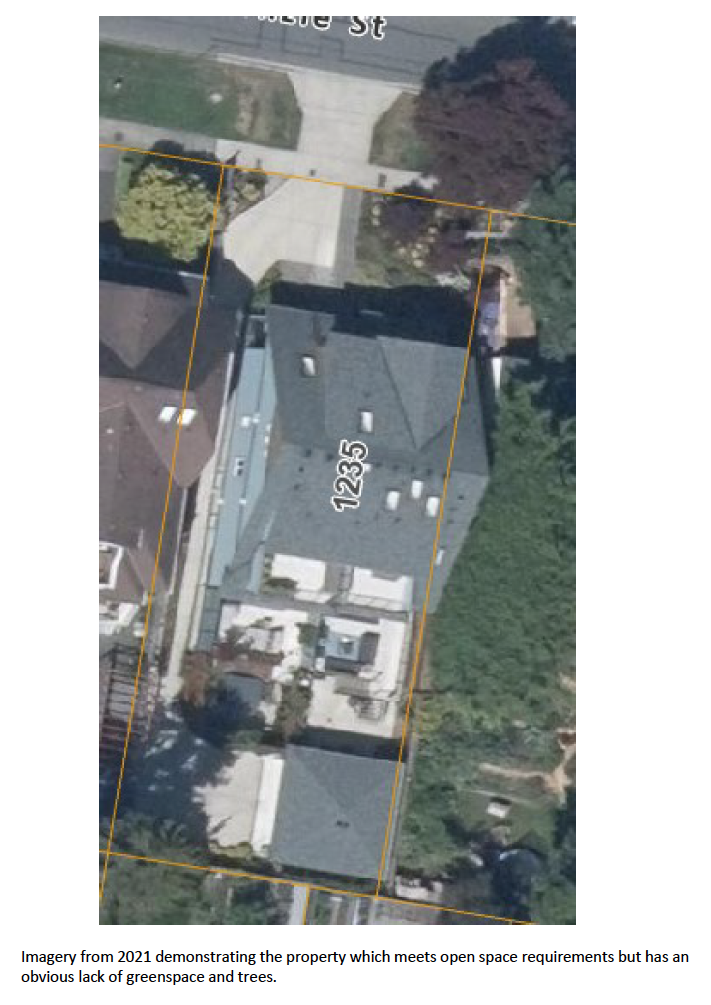
In future, the City plans to eliminate MMH Design Guidelines and replace it with design guidelines for the new OCP.
And even though provincial legislation calls for “small-scale multi-family housing of 3 to 4 units” on single-family and duplex lots, depending on size of property in residential areas, the OCP increases density city-side from units to storeys (city-wide):
- 4-storeys (light yellow)
- 6-storeys (dark yellow),
- Community villages up to 12 storeys (purple)
- Town Centres up to 18 storeys on Oak Bay Avenue (blue)
- Local villages 4-storeys (red).
A summary of the zoning modernization changes is available on the City website at https://engage.victoria.ca/ocp.
Includes:
Block perimeter housing city-wide
Reduced setbacks, generally at 4m (front), 1.5m (sides), and 6-8m (backyard).
Reduced Open Lot Space from 45% to 30%
Landscape area at 6% of Lot Area
Significantly, the new land use class scheme was determined without a City-wide biodiversity assessment on private property, presenting an obstacle to stewardship and conservation. More on that in a subsequent post.
To compound the issue of removing trees from private property, is how the City of Victoria cut the budget for Natural Areas (public spaces) in March 2025. This is partially why you’ll see new saplings on Dallas Road, for example, dying of thirst. There are other potential factors such as trees grown at an off-island nursery, and the trees needing to adapt to the ocean front environment. But it’s hardly the time for the City of Victoria to reduce the natural areas budget on public land, when there’s been an uptick in trees being removed from private property, and new developments not meeting the tree minimums.
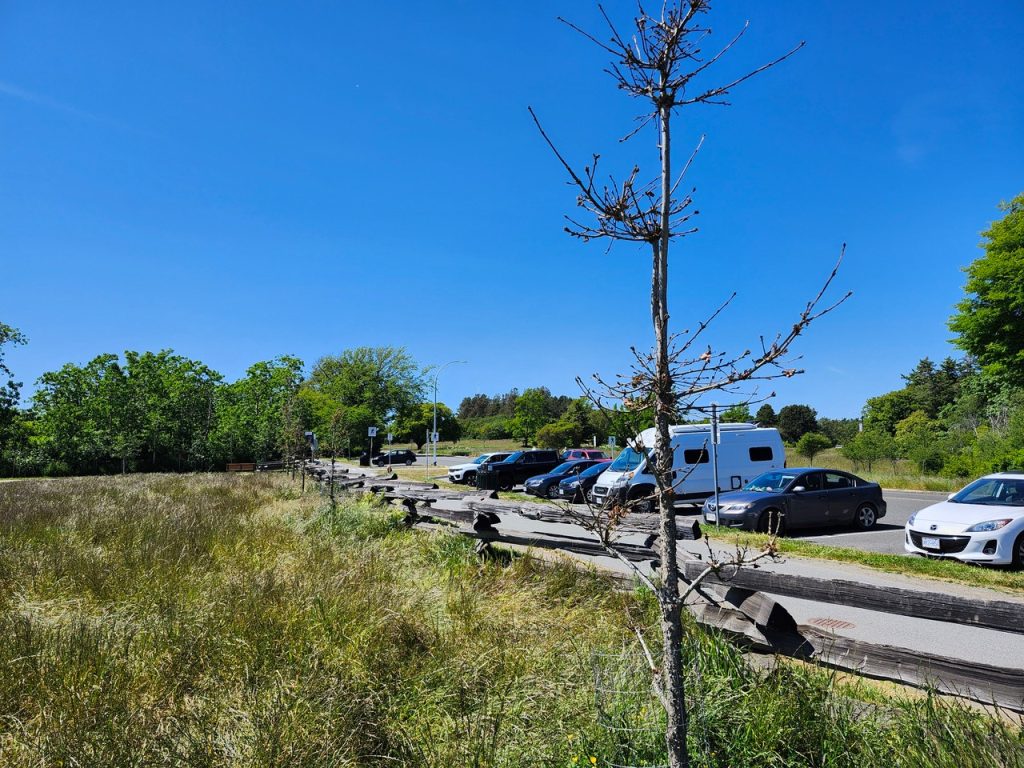
Here is a list of each municipality tree protection bylaws.
